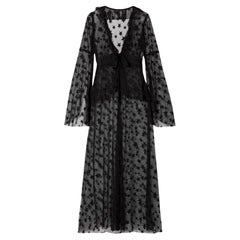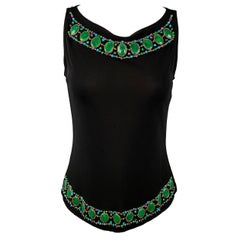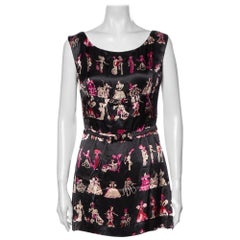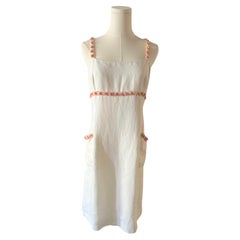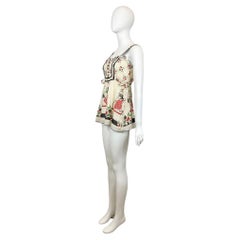Anna Sui
to
1
5
12
5
16
1
17
8,076
5,013
4,668
3,363
8
3
6
5
2
1
1
Designer: Anna Sui
S/S 2001 Anna Sui Black Net and Silk Raffia Duster
By Anna Sui
Located in Toronto, Ontario
Beautiful and unusual woven duster jacket from the Anna Sui Spring Summer 2001 runway show. The woven material is a combination of a stiff thread and a softer silk in a raffia style....
Category
Early 2000s British Anna Sui
Anna Sui Shooting Star Tulle Coat
By Anna Sui
Located in London, GB
Witchy chic Anna Sui shooting star tulle light coat. bought for £390 and worn once. Made from super soft black nylon tulle with star design, it has flowing, split sleeves, front ruff...
Category
2010s French Anna Sui
1990s Vintage Anna Sui Brown Heart Crochet Lace Spaghetti Strap 90s Tank Top
By Anna Sui
Located in San Diego, CA
Rare 1990s ANNA SUI vintage tan top ! Features brown cotton fabric with blue, brown, tan and yellow crochet / lace detail on center front in the nape of a heart.
Simply slips over t...
Category
1990s American Anna Sui
90s Anna Sui silk slip dress with floral print
By Anna Sui
Located in Austin, TX
1990s Anna Sui silk slip dress with floral print
Lace trim
Condition: Excellent
100% silk
29" bust, 29" waist, 47" hips, 35.75" length
size S / US 4
Category
1990s North American Anna Sui
ANNA SUI Size 6 Black Beaded Rayon Tank Dress Top
By Anna Sui
Located in San Francisco, CA
ANNA SUI tank dress top comes in a black rayon featuring a beaded trim design and a boat neck. Made in USA.Very Good
Pre-Owned Condition.
Marked: 6
Measurements:
Shoulder: 1...
Category
21st Century and Contemporary Anna Sui
$108 Sale Price
20% Off
1990s Anna Sui Victorian Print Silk Mini Dress
By Anna Sui
Located in Austin, TX
1990s Anna Sui black silk mini dress with Victorian print. Size 42/ US S
29" length, 34" bust, 32" waist. Condition: Excellent.
Category
1990s American Anna Sui
Anna Sui 2000s Teal Handkerchief Midi Dress
By Anna Sui
Located in Scottsdale, AZ
The Anna Sui 2000s Teal Handkerchief Midi Dress is a captivating blend of rich greens and blues, crafted from a felt material that offers both comfort and style. The dress features a...
Category
Early 2000s American Anna Sui
1990S Anna Sui Yellow Rayon Slip Dress With Lace
By Anna Sui
Located in New York, NY
1990S Anna Sui Yellow Rayon Slip Dress With Lace
Category
1990s Anna Sui
1990s Vintage Anna Sui ' Cubism ' Modernist Cotton Tunic Top Or 90s Mini Dress
By Anna Sui
Located in San Diego, CA
Awesome vintage ANNA SUI 'Cubism' themed cotton tunic top (or mini dress)! A rare piece from Sui's early career. Amazing print on both the front and b...
Category
1990s American Anna Sui
Anna Sui Duster Coat in Pale Lemon
By Anna Sui
Located in London, GB
A pretty duster coat in a pale lemon colour by Anna Sui. The coat has a cut out leaf print, with cap sleaves and a ribbon tie at the front. It has pin tucks o...
Category
2010s American Anna Sui
ANNA SUI Size 6 Black Polyester Mixed Fabrics Short Sleeve Cocktail Dress
By Anna Sui
Located in San Francisco, CA
ANNA SUI cocktail dress
in a black polyester featuring a mixed fabrics design, short puffy sleeves, and V-neck with ribbon accent.
Made in USA.Very Good Pre-Owned Condition. Minor sn...
Category
21st Century and Contemporary Anna Sui
Anna Sui Cocktail /Bridal Dress
By Anna Sui
Located in London, GB
A fun frock by Anna Sui, perfect for a party or a wedding. The dress has a round neckline, elbow length sleaves and scallop hem. The outer fabric is a silk mi...
Category
2010s Unknown Anna Sui
Anna Sui Black Lace Ruffle Trimmed Long Sleeve Blouse M
By Anna Sui
Located in Dubai, Al Qouz 2
The intricate and attractive lace detailing make this Anna Sui blouse desirable. Tailored from a mix of quality materials it features long sleeves ruffled trims and a zipper closure....
Category
2010s Anna Sui
Anna Sui Multicolor Printed Silk Ruffled Sleeveless Top S
By Anna Sui
Located in Dubai, Al Qouz 2
What an amazing sight this top brings! The Anna Sui silk creation flaunts a sleeveless style with slender shoulder straps, tie fastening at the rear, and ruffles. The top will give y...
Category
21st Century and Contemporary Anna Sui
Anna Sui Black Sequin Embellished Silk Pleated Detail Belted Top S
By Anna Sui
Located in Dubai, Al Qouz 2
Perfect for night-time events and parties, this Anna Sui top will shine bright under the evening lights. It has been crafted from luxurious silk and embellished with dazzling sequins...
Category
21st Century and Contemporary Anna Sui
Anna Sui Gold Knitted Geometric Design High Waist Wide Leg Trouser M
By Anna Sui
Located in Dubai, Al Qouz 2
Comfort with the right element of statement style. Designed by Anna Sui, the high-waist trousers feature a wide-leg silhouette, zip closure, and geometric patterns all over.
Category
21st Century and Contemporary Anna Sui
Anna Sui Teal Blue Bouquet Scarf Print Silk Ribbed Trim Tunic Top M
By Anna Sui
Located in Dubai, Al Qouz 2
Look smart with this stunning top from Anna Sui that offers the finest of this season's trends. This teal blue creation is tailored in a silk blend featuring a bouquet scarf print al...
Category
21st Century and Contemporary Anna Sui
Related Items
Vintage S/S 2004 Roberto Cavalli Corset Lace Up Halter Mini Dress Zebra Graphic
By Roberto Cavalli
Located in Denver, CO
Vintage S/S 2004 Roberto Cavalli Dress
Abstract geometric + zebra print fabric silk fabric with metallic gold painted accents
Halter neckline
Plunging neckline with lace up detail at...
Category
Early 2000s Anna Sui
Spring 1996 Chanel Floral Sequin Strap Dress
By Chanel
Located in San Francisco, CA
Floral sequin trim ran throughout Karl Lagerfeld's iconic Spring 1996 Chanel runway show, and this lovely little vintage dress is the perfect embodiment of that. Would be ideal for a...
Category
1990s Anna Sui
Hussein Chalayan 1990s Layered Slip Dress
By Hussein Chalayan
Located in COLLINGWOOD, AU
Hussein Chalayan 1990s Layered Slip Dress in oyster beige silk.
Features draped cowl neckline and sheer silk knit lining.
A true collector's piece.
Size 42.
Made in Italy
Category
1990s Italian Anna Sui
Gucci by Tom Ford Ivory Backless Jersey Dress with GG Clasp, S/S 1998
By Tom Ford for Gucci
Located in Kingston, NY
From Tom Ford’s Spring/Summer 1998 collection for Gucci, this ivory backless dress is the epitome of minimalist seduction and '90s-era sophistication. Designed in a fluid, body-skimm...
Category
1990s Italian Anna Sui
Vintage 2007 2000s Y2K Roberto Cavalli Halter Cheetah Animal Leopard Print Dress
By Roberto Cavalli
Located in Denver, CO
Vintage 2007 Roberto Cavalli Dress
Stretch fabric with cheetah print
Halter neckline
Low cut
Gold metal closure detail at the bust
Gathered fabric band at the waist
Knee length A lin...
Category
Early 2000s Anna Sui
CHANEL black/white silk satin dress FR 40 Fall 2001 01A
By Chanel
Located in Rubiera, RE
CHANEL Fall 2001
Elegant dress in black and white silk satin with drapery on the neckline. Short sleeves. Side pockets.
Zip closure on the back.
size FR 40
Made in France
100% silk
...
Category
Early 2000s French Anna Sui
$1,345 Sale Price
20% Off
Dm 15.36 in L 38.19 in
Chanel 2016 Ribbon Embellished Mini Dress Little Black Dress 36
By Chanel, Karl Lagerfeld for Chanel
Located in Merced, CA
Chanel ribbon embellished little black dress with Chanel interlocking CC logo emblem and from pockets. This is pre-owned in excellent condition.
Category
2010s French Anna Sui
Vintage 1990s Lemon Yellow Pink Roses Floral Emanuel Ungaro Ruffle Maxi Dress
By Emanuel Ungaro
Located in Denver, CO
Vintage Early 90s Emanuel Ungaro Dress
Lemon yellow silk fabric with pink roses flowers
Thin shoulder straps
V neckline trimmed in ruffle fabric
Wrap style dress with long ties that...
Category
1990s Anna Sui
Yves Saint Laurent by Tom Ford FW-2003 Cotton Jersey Draped Sleeveless Top
By Yves Saint Laurent Rive Gauche, Tom Ford for Yves Saint Laurent
Located in Brussels, BE
A highlight from the Fall/Winter 2003 YSL collection, this sensually draped top emphasizes every curve, while the semi-sheer finish of its jersey does not leave much room to the imag...
Category
Early 2000s Italian Anna Sui
Pleats Please by Issey Miyake Vintage Black Fringe Top
By Pleats Please
Located in Melbourne, VIC
Pleats Please by Issey Miyake combines timeless design with an avant-garde edge, and this vintage fringe top is no exception. Crafted from the brand...
Category
Early 2000s Japanese Anna Sui
Prada’s Long Sleeve Top - Spring-Summer 2017 September Runway
By Miuccia Prada, Prada
Located in Iba, PH
Seen in Prada’s Spring-Summer 2017 September Runway show look 22.
Prada focuses on feathers for spring 2017. This top with a geometric pattern
is a statement piece with feather cuff ...
Category
21st Century and Contemporary Italian Anna Sui
JOHN GALLIANO Top in maglia verde pastello in lana degradè FW 2006
Located in Milano, IT
Top in maglia in lana degradè di John Galliano della collezione
Ready to Wear Autunno Inverno 2006. Il top è decorato, sul davanti, da pieghe fissate in diagon...
Category
Early 2000s Anna Sui
Previously Available Items
ANNA SUI Size S Black Blue Purple Polyester Abstract Long Sleeve Long Dress
By Anna Sui
Located in San Francisco, CA
ANNA SUI dress
in a black, blue, and purple polyester fabric featuring a pleated style, rib knit cuffs and neckline, and a maxi length. Made in USA.Excellent Pre-Owned Condition.
M...
Category
21st Century and Contemporary Anna Sui
2000s Anna Sui Silk micro mini dress with floral print
By Anna Sui
Located in Austin, TX
2000s Anna Sui Silk micro mini dress with floral print
Ruffle Embellishment
Zip Closure at Back
100% Silk; Lining 100% Acetate
Bust: 30.75", Waist: 28.7...
Category
1990s North American Anna Sui
Anna Sui Teal Blue Bouquet Scarf Print Silk Ribbed Trim Tunic Top M
By Anna Sui
Located in Dubai, Al Qouz 2
Look smart with this stunning top from Anna Sui that offers the finest of this season's trends. This teal blue creation is tailored in a silk blend featuring a bouquet scarf print al...
Category
2010s Anna Sui
Anna Sui Black Sequin Embellished Silk Pleated Detail Belted Top S
By Anna Sui
Located in Dubai, Al Qouz 2
Perfect for night-time events and parties, this Anna Sui top will shine bright under the evening lights. It has been crafted from luxurious silk and embellished with dazzling sequins...
Category
2010s Anna Sui
Anna Sui Multicolor Printed Silk Ruffled Sleeveless Top S
By Anna Sui
Located in Dubai, Al Qouz 2
What an amazing sight this top brings! The Anna Sui silk creation flaunts a sleeveless style with slender shoulder straps, tie fastening at the rear, and...
Category
2010s Anna Sui
ANNA SUI Size M Black Polyester Textured Faux Fur Coat
By Anna Sui
Located in San Francisco, CA
ANNA SUI coat comes in a black textured faux fur featuring a large collar design, patch pockets, and a buttoned closure. Made in USA.
Very Good
Pre-Owned...
Category
21st Century and Contemporary Anna Sui
S/S 2001 Anna Sui Tie Front Stretch Bodycon Cutout Black T-Shirt
By Anna Sui
Located in West Hollywood, CA
Presenting a fabulous black Anna Sui tie top. From the Spring/Summer 2001 collection, a version of this top debuted on the season's runway as part of look 4, modeled by Jenny Vatheur...
Category
Early 2000s American Anna Sui
Anna Sui Gold Knitted Geometric Design High Waist Wide Leg Trouser M
By Anna Sui
Located in Dubai, Al Qouz 2
Comfort with the right element of statement style. Designed by Anna Sui, the high-waist trousers feature a wide-leg silhouette, zip closure, and geometric patterns all over.
Category
2010s Italian Anna Sui
Anna Sui Paisley Silk Blend Pleated Peplum Sheer Blouse c 1990s US Size 4
By Anna Sui
Located in University City, MO
Anna Sui Paisley silk blend pleated peplum sheer blouse c 1990sUS Size 4
The vibrant silk blend blouse is infused with bold intricate paisley swirl
graphics in golden-amber colors; i...
Category
1990s American Anna Sui
1990'S ANNA SUI Floral Bias Cut Rayon & Silk Burnout Velvet Iconic Grunge Coll
By Anna Sui
Located in New York, NY
1990'S ANNA SUI Floral Bias Cut Rayon & Silk Burnout Velvet Iconic Grunge Collection Slip Dress
Category
1990s Anna Sui
1990'S ANNA SUI Tan Sheer Viscose Chiffon Iconic Grunge Collection Floral Slip
By Anna Sui
Located in New York, NY
1990'S ANNA SUI Tan Sheer Viscose Chiffon Iconic Grunge Collection Floral Slip Dress As Seen In Vogue
Category
1990s Anna Sui
1990S ANNA SUI Black Silk Chiffon Iconic & Famous Ballerina Baby Doll Dress Fro
By Anna Sui
Located in New York, NY
1990S ANNA SUI Black Silk Chiffon Iconic & Famous Ballerina Baby Doll Dress From The Grunge Collection
Category
1990s Anna Sui
Anna Sui fashion for sale on 1stDibs.
Find an extraordinary range of authentic Anna Sui fashion available on 1stDibs. Customers who are interested in this designer might also find the work of Judith Ann, John Elliott, and The Silk Farm appealing. On 1stDibs, find haute couture, vintage and designer Anna Sui fashion from top boutiques around the world. Anna Sui fashion prices can differ depending upon time period and other attributes. On 1stDibs, the price for these items starts at $136 and tops out at $1,036, while the average work can sell for $391.
Designers Similar to Anna Sui
Questions About Anna Sui
- Is Anna Sui Chinese?1 Answer1stDibs ExpertMay 30, 2024Yes, Anna Sui is Chinese in terms of her ethnic heritage. However, she was born in Detroit, Michigan, in 1964. Her parents were born in China and met while studying in Paris, France; they later relocated to the United States. Find a collection of Anna Sui apparel and accessories on 1stDibs.
- 1stDibs ExpertFebruary 7, 2024Anna Sui is known for designing apparel and accessories that draw inspiration from the history of art, fashion, photography and music. She unveiled her first fashion collection in 1981. Ten years later, she hosted her first runway show, featuring supermodels Naomi Campbell and Linda Evangelista. She has received several awards, including the CFDA Perry Ellis Award for New Talent, the China Fashion Awards Classic Icon of Fashion Design Award and the CFDA Geoffrey Beene Lifetime Achievement Award. On 1stDibs, shop a range of Anna Sui apparel and accessories.
- Is Anna Sui a luxury brand?1 Answer1stDibs ExpertApril 16, 2024Yes, Anna Sui is a luxury brand. Since its launch in 1981, the brand has become synonymous with producing well-made pieces that draw inspiration from vintage fashion. The clothing, shoes, eyewear and accessories that bear the Anna Sui name feature fine materials, including custom fabric prints. Explore an assortment of Anna Sui apparel and accessories on 1stDibs.

